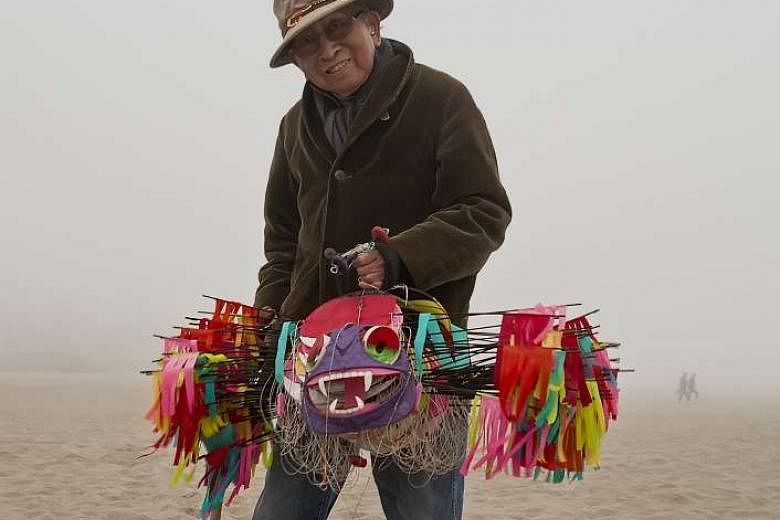When Walt Disney's Bambi opened in 1942, critics praised its spare, haunting visual style, vastly different from anything Disney had done before.
But what they did not know was that the film's striking appearance had been created by a Chinese immigrant artist, who took as his inspiration the landscape paintings of the Song dynasty. The extent of his contribution to Bambi, which remains a high-water mark for film animation, would not be widely known for decades.
Like the film's title character, the artist, Tyrus Wong, weathered separation from his mother - and, in the hope of making a life in the United States, incarceration, isolation and interrogation - as a child.
In the years that followed, he endured poverty, discrimination and lack of recognition, not only for his work at Disney, but also for his fine art, before finding acclaim in his 90s. He died last Friday aged 106.
A Hollywood studio artist, painter, printmaker, calligrapher, greeting-card illustrator and, in later years, kite-maker, he was one of the most celebrated Chinese-American artists of the 20th century. But because of the marginalisation of Asian-Americans, he passed much of his career unknown to the public.
Trained as a painter, he was a leading figure in the modernist movement that flourished in California between World War I and World War II. In 1932 and again in 1934, his work was included in group shows at the Art Institute of Chicago that also featured Picasso, Matisse and Paul Klee.
As a staff artist for Hollywood studios from the 1930s to the 1960s, he drew storyboards and made detailed paintings that helped the director envision each scene before it was shot.
Over the years, his work informed the look of animated pictures for Disney and live-action films for Warner Bros and other studios, among them The Sands Of Iwo Jima (1949), Rebel Without A Cause (1955) and The Wild Bunch (1969).
But of the dozens of films on which he worked, it was for Bambi that Wong was - belatedly - most renowned.
"He was truly involved with every phase of production," said Mr John Canemaker, an Oscar-winning animator and a historian of animation at New York University. "He created an art direction that had never been seen before in animation."
He was born Wong Gen Yeo on Oct 25, 1910, in a farming village in Guangdong province. As a child, he exhibited a love of drawing and was encouraged by his father.
In 1920, seeking better economic prospects, he and his father embarked for the US, leaving his mother and sister behind. He would never see his mother again.
From 1936 to 1938, he was an artist for the Works Progress Administration, creating paintings for libraries and other public spaces.
Newly married and needing steady work, he joined Disney in 1938 as an "in-betweener", creating the thousands of intermediate drawings that bring animated sequences to life.
In the late 1930s, he learnt that Disney was adapting Bambi, A Life In The Woods, the 1923 novel by Austrian writer Felix Salten about a fawn whose mother is killed by a hunter.
In trying to animate the book, the studio had reached an impasse. It had enjoyed great success in 1937 with its animated film Snow White And The Seven Dwarfs, in which every detail of the backgrounds was meticulously represented. But in an attempt to use a similar style for Bambi, it found that the ornate backgrounds camouflaged the deer and other forest creatures which the narrative centred on.
Wong spied his chance.
"I said, 'Gee, this is all outdoor scenery,'" he recalled in a video interview years afterwards, adding: "I said, 'Gee, I'm a landscape painter!'" Invoking the exquisite landscape paintings of the Song dynasty, he rendered in watercolours and pastels a series of nature scenes that were moody, lyrical and atmospheric - at once lush and spare - with backgrounds subtly suggested by a stroke or two of the brush.
"Walt Disney went crazy over them," said Mr Canemaker. "He said, 'I love this indefinite quality, the mysterious quality of the forest.'" Wong was unofficially promoted to inspirational sketch artist.
"But he was more than that," Mr Canemaker explained. "He was the designer; he was the person they went to when they had questions about the colour, about how to lay something out. He even influenced the music and the special effects: Just by the look of the drawings, he inspired people."
Wong spent two years painting the illustrations for Bambi. But in 1941, in the wake of a bitter employees' strike that year, Disney fired him. On Bambi, his name appears, quite far down in the credits, as a mere "background" artist.
He joined Warner Bros in 1942, working there - and lent out on occasion to other studios - until his retirement in 1968.
Wong, who became a US citizen in 1946, also designed Christmas cards for Hallmark and painted Asian-inflected designs on dinnerware.
A long-time resident of Sunland, California, he became, in retirement, a renowned kite-maker, designing, building and hand-colouring creations more than 30m long.
His death, at his home in Sunland, was confirmed by film-maker Pamela Tom. His survivors include three daughters, Kay Fong, Wong Tai-Ling and Kim Wong; and two grandchildren.
When his daughters were small, he encouraged them to make art, as his father had encouraged him. Yet he would not let them have colouring books.
The reason was simple: He did not want his children constrained, he said, by lines laid down by others.
NYTIMES

